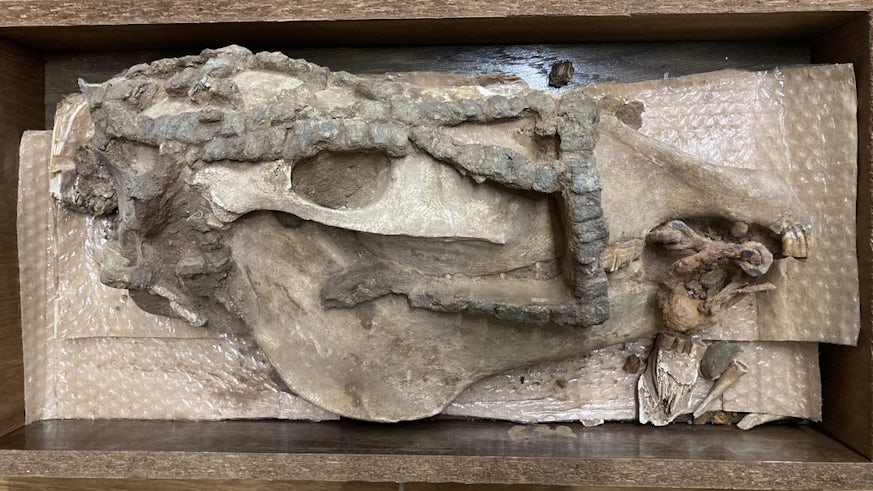Hoofing It – uncovering the mystery of Baltic graves holding horses and humans over a millennia
20 September 2022

Experts are set to unlock the secrets of communities that famously treasured horses over centuries in a new international multi-discipline project.
Bioarchaeologists and scientists are collaborating to understand public rituals that were central to the culture of the Baltic tribes from the end of the Roman period, through the tumultuous Migration and Viking periods, into the medieval period when they faced forced conversion and colonisation by Germanic crusading orders.
Thousands of horses throughout the south-eastern Baltic region have been found in human cemeteries the 2nd up to the 14th centuries AD. Sacrifice as part of ostentatious public funerals on such scale has long intrigued archaeologists.
Experts from 6 European centres are investigating the intriguing ritual life of Baltic tribes in a comprehensive study of animal deposits in sacred spaces building on exciting innovations in archaeological science. Baltic horse sacrifices have been studied for over 100 years, but we now have the technology to address longstanding questions. Why were individuals chosen? How were they sacrificed? To what extent did other animals have ritual significance? And how did turbulent periods impact the ritual life of Baltic communities over time?
The Baltic paganism, Osteology, and New Evidence from Zooarchaeology (BONEZ) project, led by Dr Katherine French and supervised by Dr Richard Madgwick, is widening attention into these intriguing cultural practices. Over two years, the BONEZ team are combining established and novel techniques operating at the macroscopic, microscopic and molecular level to reconstruct the life histories of the horses and other animals to understand why they may have been chosen for specific rites and what resources went into maintaining such a system.
The resulting data will show how public rituals changed over time indicating the evolving nature of these Baltic communities from the end of the Roman to the Early Medieval periods, featuring sites over 90,000 km2 from north-eastern Poland and Lithuania to Kaliningrad in modern-day Russia.
This multi-scalar research will be a key case-study in integrated osteological analysis of complex skeletal assemblages, providing a blueprint for researchers addressing similar questions across wide-ranging contexts.
In a world first, the research team will narrate the processing of animals from the molecular level to a regional analysis of ritual variability across the Eastern Baltic region. Using brand new techniques in the analysis of strontium isotopes from burnt bone, the research will transform understanding of horse and human mobility, with the capability to unlock research potential in other arenas.
Leading the study, Dr French explains:
“This new framework for integrating different types of evidence on multiple scales can reconstruct ritual activity from underutilized skeletal assemblages. Traditionally, poorly preserved skeletal deposits or burnt bone were not particularly informative. With advancements in aDNA, isotope analysis, histology, and proteomics, we now have the ability to reconstruct, for example, where a horse was born and raised, its sex, perhaps coat colour – all from a single tooth.
“Combining molecular analyses with traditional osteology and histology provides the most comprehensive reconstruction of an animal’s life, death, and ritual significance. We call this integration of methods the Multiproxy Osteological Toolkit. With applicability to any geographical or temporal context, our toolkit will have far-reaching legacy benefits in enhancing interpretative potential of other previously neglected skeletal deposits.”
Among the BONEZ team are Cardiff University’s Reader in Archaeological Science Dr Richard Madgwick, Professor John Hines, Dr Morten Anderson and Dr Marc-Alban Millet (co-directors of Cardiff Earth Laboratory for Trace elements and Isotope Chemistry) and project partners Professor Aleksander Pluskowski (University of Reading), Professor Matthew Collins (Cambridge University), Dr Linas Daugnora (Klaipėda University, Lithuania), Professor Maciej Karczewski (University of Białystok, Poland), Dr Roman Shiroukhov (Centre for Baltic and Scandinavian Archaeology, Schleswig, Germany), and Professor Katarzyna Ropka-Molik (National Research Institute of Animal Production, Poland).
Begun in September 2021 Baltic paganism, Osteology, and New Evidence from Zooarchaeology is funded by Marie Skłodowska-Curie Fellowship, European Union’s Horizon 2020 research and innovation programme [€224,934, grant agreement 893072]. For latest updates, follow the project on Instagram.
Bioarchaeologist of the medieval period, researcher Dr Katherine French focuses on the symbolic and religious importance of animals to communities.
